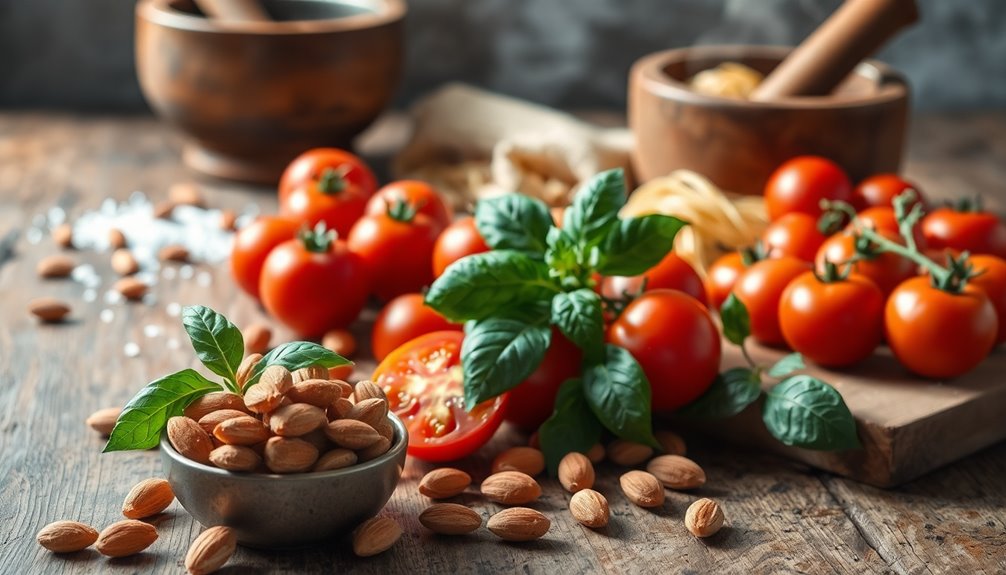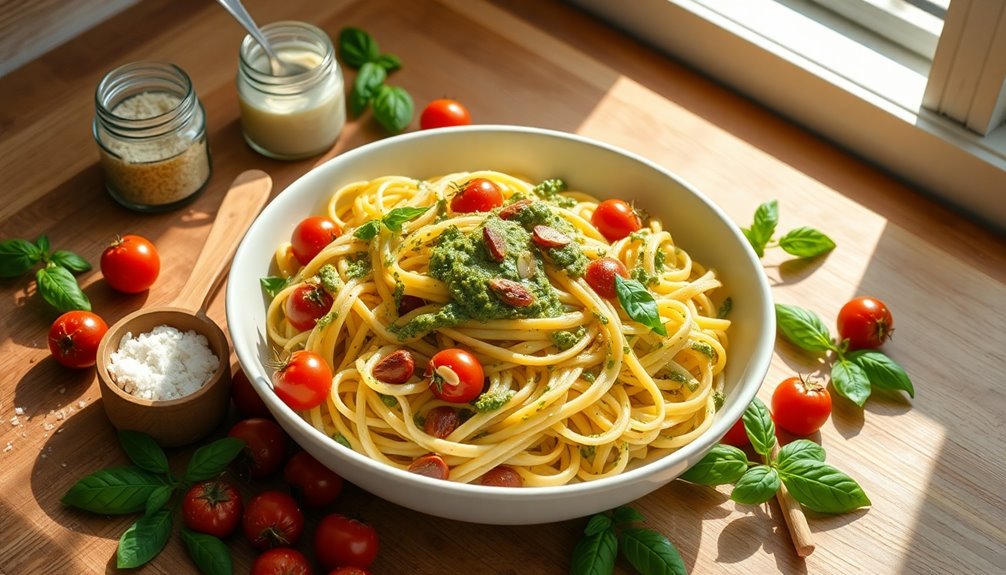Pasta with almond and tomato confit pesto is a delightful dish that captures the essence of summer gatherings. Slow-roasting ripe cherry tomatoes intensifies their sweetness, while blending them with roasted almonds and fresh basil creates a rich, nutty pesto. Toss your favorite pasta in this vibrant mixture, and finish it off with a drizzle of high-quality olive oil and a sprinkle of Parmesan cheese. If you want to explore the history and cooking techniques, keep going!
History

When you delve into the history of pasta with almond and tomato pesto, you'll discover its roots in the Sicilian city of Trapani. This traditional dish, known as Pasta alla Trapanese, beautifully combines fresh ingredients like tomatoes and almonds, showcasing the essence of Mediterranean cuisine.
The technique of making tomato confit enhances the sweetness of tomatoes, reflecting the culinary practices that celebrate seasonal produce. The use of almonds in pesto stems from the historical influence of Arab cuisine on Sicilian cooking, where nuts were a staple.
Over time, almonds became a popular substitute for pine nuts, making this rich-flavored pesto more accessible. Today, the modern twist of incorporating preserved items highlights the dish's versatility and enduring appeal. Additionally, the focus on sustainable farming practices ensures that the ingredients used are fresh and locally sourced, further enriching the dish's flavor profile.
Recipe

To get started, gather all your ingredients and set your oven to 400°F.
While the tomatoes roast, you can prepare the almond pesto, ensuring that every component is fresh and full of flavor. The combination of roasted tomatoes and almond pesto creates a beautiful and delicious pasta dish that's sure to impress. Serve it with a sprinkle of Parmesan cheese on top for an extra touch of flavor and a lovely presentation. Additionally, you might want to consider making sugar-free vanilla ice cream for a delightful dessert to accompany your meal.
Ingredients:
- 1 pound pasta (your choice)
- 1 pint cherry tomatoes, halved
- 3 tablespoons olive oil, divided
- 2 cloves garlic, minced
- Salt and pepper, to taste
- 1 cup roasted almonds
- 1 cup fresh basil leaves
- 2 cloves garlic
- ½ cup grated Parmesan cheese
- Reserved pasta cooking water
Cooking Instructions:
Preheat your oven to 400°F.
Place the halved cherry tomatoes on a baking sheet and drizzle with 2 tablespoons of olive oil, adding minced garlic, salt, and pepper. Roast in the oven for 15-20 minutes until the tomatoes are slightly shriveled and caramelized.
Meanwhile, cook the pasta according to package instructions until al dente.
In a blender, combine the cooled roasted almonds, fresh basil, garlic, Parmesan cheese, and the remaining olive oil, blending until smooth.
Adjust the consistency with reserved pasta cooking water as needed, then toss the cooked pasta with the almond pesto.
Top with the roasted confit tomatoes and additional Parmesan cheese before serving.
Extra Tips:
For an added layer of flavor, consider adding a squeeze of fresh lemon juice to the pesto before blending.
This will brighten the flavors and enhance the overall dish.
If you prefer a vegan version, simply omit the Parmesan cheese or substitute it with a vegan alternative.
Additionally, feel free to customize the pasta shape and type based on your preference, as this dish works well with various pasta styles.
Enjoy your vibrant summer meal!
Cooking Steps

To start making your pasta with almond and tomato pesto, you'll want to prepare the tomato confit first.
Once that's ready, blend the almonds and tomatoes together, then season with salt and pepper for that perfect flavor.
Don't forget to add the olive oil gradually while mixing in the fresh basil leaves for a rich, vibrant pesto. Additionally, using fresh ingredients can significantly enhance the brewing experience of the dish.
Step 1. Prepare the Tomato Confit

As you prepare the tomato confit, preheat your oven to 250°F (120°C) and arrange halved cherry or grape tomatoes on a baking sheet lined with parchment paper.
Drizzle the tomatoes with olive oil, then season with minced garlic, salt, and pepper to enhance their flavor.
Roast the tomatoes in the oven for 2 to 3 hours until they're slightly shriveled and tender, allowing the natural sugars to caramelize beautifully.
Once done, let the confit cool before incorporating it into your pasta dish; it adds a rich, sweet flavor to the pesto.
If you have leftovers, store them in an airtight container submerged in olive oil for up to a week in the refrigerator, preserving their taste and texture. Additionally, using flavored butters can elevate the dish's overall taste profile when combined with the confit.
Step 2. Blend Almonds and Tomatoes

With the tomato confit ready to go, it's time to blend the almonds and tomatoes for your pesto.
Start by toasting the almonds in a skillet for 2 to 4 minutes until they're golden and fragrant.
Once cooled, combine the toasted almonds with quartered ripe tomatoes, fresh basil, garlic, and red wine vinegar in a food processor.
Blend until smooth, then drizzle in olive oil while processing to emulsify.
If your pesto's too thick, adjust the consistency with reserved pasta cooking water until it's creamy.
Make sure everything's evenly blended and well-combined.
This flavorful pesto is now ready to toss with your cooked pasta for an irresistible dish! Adding a touch of chocolate peanut butter bars can elevate the overall flavor experience of your meal.
Step 3. Season With Salt and Pepper

Season your pasta and pesto generously with salt and pepper to elevate their flavors.
Use kosher salt for its coarse texture, allowing it to dissolve easily and distribute evenly throughout the dish. Freshly cracked black pepper adds a subtle heat, enhancing the depth of your almond and tomato confit pesto.
As you mix the pesto with the pasta, taste as you go and adjust the seasoning accordingly. Remember, the cheese you add, like Parmesan or Pecorino, can influence the overall saltiness.
If the dish needs more flavor, don't hesitate to incorporate additional salt or pepper. This careful seasoning ensures a delicious balance, enhancing every bite of your pasta dish. Additionally, consider how proper tipping reflects appreciation for the chef's skill, similar to how seasoning enhances the overall dining experience.
Happy cooking!
Step 4. Add Olive Oil Gradually

To achieve a smooth and creamy pesto, gradually add olive oil while processing the mixture. Start with about 1/4 cup and slowly drizzle it in through the feed tube of your food processor or blender.
This technique promotes better emulsification, ensuring that the oil blends evenly with the other ingredients. It's important to monitor the consistency as you go; if you prefer a thinner pesto, feel free to add more oil to adjust the thickness.
Additionally, adding olive oil gradually helps control the flavor intensity, balancing the richness of the oil with the freshness of the other ingredients. This careful approach will enhance your pesto, making it delicious and perfectly textured. Moreover, using high-quality natural and organic ingredients can significantly elevate the overall flavor profile of your dish.
Step 5. Incorporate Fresh Basil Leaves

As you prepare to make your almond and tomato confit pesto, incorporating fresh basil leaves is essential for achieving that vibrant flavor. Use a large handful, about 1 cup packed, to ensure a robust basil taste in your almond pesto.
When you're nearly done blending, add the fresh basil to the blender along with the toasted almonds and garlic. This timing helps preserve the bright green color and fresh aroma of the basil.
The aromatic notes will beautifully complement the sweetness of the confited tomatoes, creating a well-balanced pesto sauce. For the best results, choose vibrant basil leaves free from blemishes, and consider adding a few right before serving to maximize their flavor impact. Additionally, the incorporation of fresh basil leaves can enhance the antioxidant content of your dish, which is beneficial for overall health.
Enjoy!
Final Thoughts

While you can enjoy pasta with almond and tomato confit pesto any time of year, it truly shines during the summer months when tomatoes are at their peak.
This recipe combines the rich, nutty flavor of almonds with the sweetness of slow-roasted tomatoes, creating a vibrant sauce perfect for warm weather. The process of making tomato confit enhances the natural sweetness, making each bite a delight.
This vibrant sauce blends rich almond flavors with the sweetness of slow-roasted tomatoes, creating a delightful summer dish.
Plus, the addition of almonds brings healthy fats and protein, elevating the dish's nutritional value. To finish, a sprinkle of cheese and a drizzle of high-quality olive oil will amplify the flavors.
Whether served warm or at room temperature, this pasta is a fantastic choice for summer gatherings. Additionally, incorporating healthy options like idli sambar into your meals can provide a nutritious balance. Enjoy every delicious bite!
Frequently Asked Questions
What Type of Pasta Goes Best With Pesto?
When it comes to choosing pasta for pesto, opt for short shapes like fusilli or penne; they'll hold the sauce perfectly.
If you prefer long pasta, such as linguine, just make sure to toss it well for even coverage.
Don't forget about whole grain or gluten-free options that add nutritional value.
Cooking the pasta al dente is key, as it absorbs the flavors of the pesto, enhancing your dish's overall taste.
What Pasta Do Italians Eat With Pesto?
When you think about what pasta Italians eat with pesto, you'll find they prefer shapes that cling to the sauce.
Trofie, a twisted pasta, is a classic choice, especially in Liguria. Linguine is also popular, as its flat surface complements the pesto's texture.
Don't forget farfalle, or "bow-tie" pasta, which captures the sauce well with its ridges.
Italians usually avoid long, thin pastas like spaghetti, since the sauce doesn't stick as effectively.
Does Pesto and Tomato Go Well Together?
Yes, pesto and tomato go incredibly well together! The sweetness of tomatoes balances the nutty, herbaceous flavors in pesto, creating a vibrant dish.
When you combine them, the acidity of the tomatoes enhances the overall taste, making each bite refreshing.
Roasting the tomatoes intensifies their natural sweetness, while the creamy texture of pesto complements the juicy tomatoes beautifully.
Together, they create a satisfying flavor and texture contrast that you're sure to enjoy!
Do You Add Pesto Before or After Cooking Pasta?
You might think adding pesto before cooking could save time, but that's not the best approach.
You should always add pesto after cooking your pasta. This way, the flavors blend beautifully, and the heat from the pasta enhances the sauce's aroma.
Plus, reserving some pasta water lets you adjust the consistency, ensuring every bite is perfectly coated.
Trust me, you'll enjoy a much more vibrant and cohesive dish this way!
Conclusion
In the kitchen, the journey is just as delicious as the destination. Now that you've crafted your pasta with almond and tomato confit pesto, remember that "a meal shared is a joy doubled." Enjoy the vibrant flavors and the satisfaction of creating something special. Whether it's a weeknight dinner or a gathering with friends, this dish is sure to impress. So gather around the table, savor each bite, and relish the moments made together.









